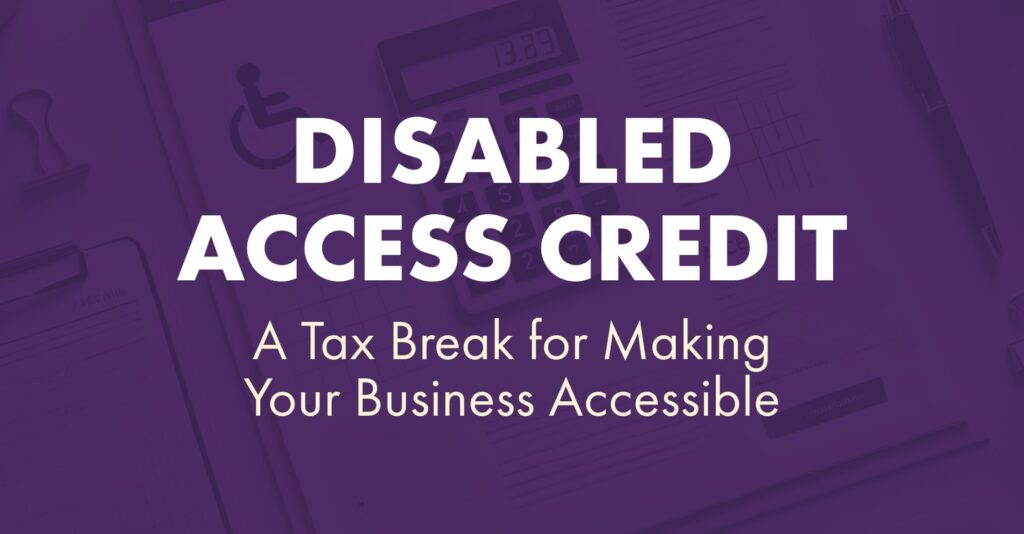Accessibility is more than just meeting compliance standards—it’s about creating an inclusive environment where everyone, regardless of ability, can participate fully. For small businesses, making their facilities accessible may seem like a costly investment, but did you know that the IRS offers a tax credit to help offset these expenses?
The Disabled Access Credit is designed to encourage small businesses to improve accessibility for people with disabilities. This credit helps cover costs associated with making facilities, digital content, and services accessible to both employees and customers. If you’re a business owner, understanding this credit could mean significant savings while also fostering inclusivity.
What Is the Disabled Access Credit?
The Disabled Access Credit (DAC) is a federal tax credit that helps small businesses cover the costs of accessibility improvements. Created under the Americans with Disabilities Act (ADA), this credit applies to businesses that take steps to remove barriers and provide accommodations for individuals with disabilities.
Eligible businesses can claim up to 50% of qualifying expenses, up to $10,250 per year, which translates to a maximum credit of $5,000.
Who Qualifies for the Disabled Access Credit?
To be eligible, businesses must:
- Have gross receipts of $1 million or less, or
- Employ 30 or fewer full-time employees in the previous tax year.
This means that the credit is designed specifically for small businesses, making it an excellent incentive for those who want to invest in accessibility without breaking the bank.
What Expenses Are Covered?
The credit applies to a variety of accessibility-related expenses, including:
Removing Physical Barriers
- Installing ramps, elevators, or wider doorways for wheelchair access.
- Modifying restrooms, parking areas, or entrances to meet ADA standards.
Accessible Communication
- Providing sign language interpreters or real-time captioning for employees or customers.
- Offering Braille, large print, or digital versions of materials for individuals with visual impairments.
Website and Digital Accessibility
- Making websites and online services compliant with the Web Content Accessibility Guidelines (WCAG).
- Implementing screen reader compatibility, keyboard navigation, and text-to-speech features.
Workplace Accommodations
- Purchasing adaptive equipment for employees with disabilities.
- Modifying workstations, seating, or assistive technology to improve accessibility.
How to Claim the Disabled Access Credit
To claim the Disabled Access Credit, businesses must file IRS Form 8826 (Disabled Access Credit) with their tax return. Here’s a step-by-step process:
- Determine your eligibility – Ensure your business meets the size and revenue criteria.
- Track qualifying expenses – Keep detailed records of accessibility-related costs.
- Calculate the credit – The IRS allows you to claim 50% of expenses exceeding $250, up to $10,250.
- File Form 8826 – Submit the form along with your business tax return.
Example Calculation:
- If you spend $8,000 on eligible accessibility improvements:
- Subtract the first $250 (not covered by the credit).
- 50% of the remaining $7,750 is $3,875 – this is the credit you can claim!
The Barrier Removal Tax Deduction: Another Accessibility Incentive
In addition to the Disabled Access Credit, businesses can take advantage of the Barrier Removal Tax Deduction. This incentive is designed to encourage businesses of all sizes—not just small businesses—to remove architectural and transportation barriers for people with disabilities and the elderly.
How It Works
Deduction Amount: Businesses may claim up to $15,000 per year for qualified expenses related to removing barriers.
Eligible Expenses: This includes modifications such as:
- Installing automatic doors, ramps, elevators, and accessible restrooms.
- Making sidewalks and parking areas wheelchair accessible.
- Improving transportation accommodations for people with disabilities.
How to Claim the Deduction
Businesses claim this deduction by listing it as a separate expense on their income tax return. No special tax form is required.
Using the Disabled Access Credit and Barrier Removal Deduction Together
Businesses may combine the Disabled Access Credit and the Barrier Removal Tax Deduction in the same tax year if their expenses qualify for both. However, the deduction must be adjusted to reflect the credit.
- Example: If a business spends $20,000 on accessibility improvements, they may:
- Claim the first $10,250 under the Disabled Access Credit (50% credit on eligible costs).
- Deduct the remaining $9,750 as a Barrier Removal Tax Deduction.
This allows businesses to maximize their tax benefits while making their facilities fully accessible.
Why These Tax Incentives Matter
Saves Your Business Money
Improving accessibility isn’t just about compliance—it’s an investment in your customers, employees, and long-term success. The Disabled Access Credit and Barrier Removal Tax Deduction help offset costs, making it more affordable.
Expands Your Customer Base
An estimated 1 in 4 adults in the U.S. has a disability. Making your business accessible means welcoming a larger audience, increasing foot traffic, and improving customer satisfaction.
Strengthens Your Brand
Consumers are more likely to support businesses that prioritize inclusivity. Publicizing your commitment to accessibility enhances your reputation and fosters brand loyalty.
Reduces Legal Risks
The ADA requires businesses to provide accessibility accommodations. Taking proactive steps to improve accessibility can help your business avoid costly lawsuits and fines.
Final Thoughts
Making your business accessible is not just the right thing to do—it’s financially smart. The Disabled Access Credit and Barrier Removal Tax Deduction help businesses save money while ensuring equal access for all customers and employees.
If your business has recently made accessibility improvements or plans to in the future, don’t miss out on these valuable tax incentives. Speak with your accountant or tax professional to ensure you maximize your tax savings while fostering a more inclusive business environment.
For more guidance on making your business fully accessible, contact Equal Accessibility® today.


